Ellery Queen is a pseudonym created in 1929 by American crime fiction writers Frederic Dannay and Manfred Bennington Lee and the name of their main fictional character, a mystery writer in New York City who helps his police inspector father solve baffling murders. Dannay and Lee wrote most of the more than thirty novels and several short story collections in which Ellery Queen appeared as a character, and their books were among the most popular of American mysteries published between 1929 and 1971. In addition to the fiction featuring their eponymous brilliant amateur detective, the two men acted as editors: as Ellery Queen they edited more than thirty anthologies of crime fiction and true crime, and Dannay founded and for many decades edited Ellery Queen's Mystery Magazine, which has been published continuously from 1941 to the present. From 1961, Dannay and Lee also commissioned other authors to write crime thrillers using the Ellery Queen nom de plume, but not featuring Ellery Queen as a character; several juvenile novels were credited to Ellery Queen, Jr. Finally, the prolific duo wrote four mysteries under the pseudonym Barnaby Ross.

The Detection Club was formed in 1930 by a group of British mystery writers, including Agatha Christie, Dorothy L. Sayers, Ronald Knox, Freeman Wills Crofts, Arthur Morrison, Hugh Walpole, John Rhode, Jessie Rickard, Baroness Emma Orczy, R. Austin Freeman, G. D. H. Cole, Margaret Cole, E. C. Bentley, Henry Wade, Constance Lindsay Taylor and H. C. Bailey. Anthony Berkeley was instrumental in setting up the club, and the first president was G. K. Chesterton. There was a fanciful initiation ritual with an oath probably written by either Chesterton or Sayers, and the club held regular dinner meetings in London.

The Canary Murder Case (1927) is a murder mystery novel which deals with the murders of a sexy nightclub singer known as "the Canary," and, eventually, her boyfriend, solved by Philo Vance. S. S. Van Dine's classic whodunnit, second in the Philo Vance series, is said by Howard Haycraft to have broken "all modern publishing records for detective fiction." The earliest editions give the title with quotation marks around the word "Canary", but most subsequent editions omit them.
Julian Gustave Symons was a British crime writer and poet. He also wrote social and military history, biography and studies of literature. He was born in Clapham, London, and died in Walmer, Kent.
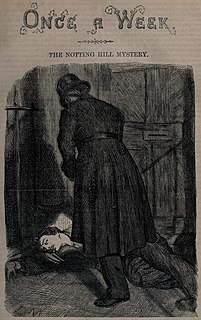
The Notting Hill Mystery (1862–1863) is an English-language detective novel written under the pseudonym Charles Felix, with illustrations by George du Maurier. The author's identity was never revealed, but several critics have suggested posthumously Charles Warren Adams (1833–1903), a lawyer known to have written other novels under pseudonyms. It is seen as one of the first detective novels in the English language, if not the first.
The Golden Age of Detective Fiction was an era of classic murder mystery novels of similar patterns and styles, predominantly in the 1920s and 1930s.

Maureen Corrigan is an American author, scholar, and literary critic. She is the book critic on the NPR radio program Fresh Air and writes for the "Book World" section of The Washington Post. In 2014, she wrote So We Read On, a book on the origins and power of The Great Gatsby. In 2005, she published a literary memoir Leave Me Alone, I'm Reading: Finding and Losing Myself in Books. Corrigan was awarded the 2018 Nona Balakian Citation for Excellence in Reviewing by the National Book Critics Circle for her reviews on Fresh Air on NPR and in The Washington Post, and the 1999 Edgar Award for Criticism by the Mystery Writers of America for her book, Mystery & Suspense Writers, with Robin W. Cook.

The Narrowing Circle is a 1954 mystery crime novel by the British writer Julian Symons. The title refers to the "narrowing circle" the investigating policemen throw around the most likely suspect.
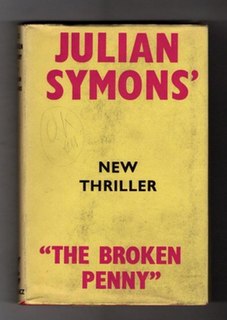
The Broken Penny is a 1953 thriller novel by the British writer Julian Symons set during the early Cold War.

The Man Who Killed Himself is a 1967 comedy crime novel by the British writer Julian Symons.

The Kentish Manor Murders is a 1988 mystery detective novel by the British writer Julian Symons. A pastiche of the traditional Sherlock Holmes stories by Arthur Conan Doyle, it is a sequel to the 1975 novel A Three-Pipe Problem.
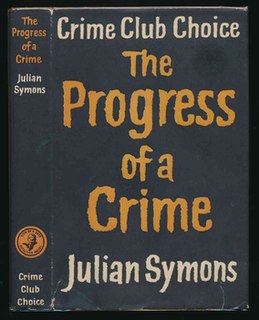
The Progress of a Crime is a 1960 mystery crime novel by the British writer Julian Symons. It was awarded the 1961 Edgar Award.
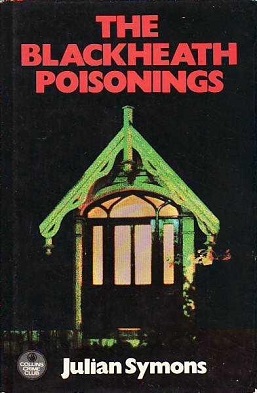
The Blackheath Poisonings is a 1978 historical mystery novel by the British writer Julian Symons. It is a murder mystery set in the late Victorian era.
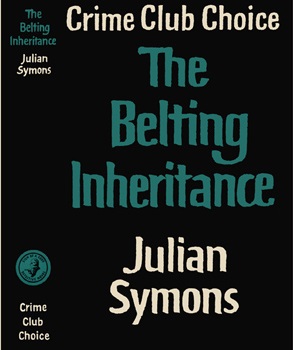
The Belting Inheritance is a 1965 mystery detective novel by the British writer Julian Symons. It is a traditional country house mystery harking back towards the Golden Age of Detective Fiction. It was republished by British Library Publishing in 2018 along with another Symons novel The Colour of Murder.

The Colour of Murder is a 1957 crime novel by the British writer Julian Symons. It was awarded the Gold Dagger of the Crime Writers' Association for that year. It was republished by British Library Publishing in 2018 along with another Symons novel The Belting Inheritance.

Sweet Adelaide is a 1980 historical crime novel by the British writer Julian Symons. It is based on the real-life 1886 Pimlico Mystery concerning the possible murder Thomas Bartlett by his wife Adelaide. Symons had already enjoyed success with another Victorian-set mystery The Blackheath Poisonings.
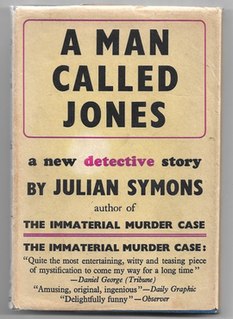
A Man Called Jones is a 1947 mystery detective novel by British writer Julian Symons. It is the second novel in his trilogy featuring the Scotland Yard detective Chief Inspector Bland. Symons was critical of the "Great Detective" that features in so many novels during the Golden Age of Detective Fiction and demonstrates this in the climatic scene where Bland assembles all the suspects to explain his theory, only to first send them to sleep and then be confronted by the late arrival of a previously unknown character on which the whole puzzle hinges.

The 31st of February is a 1950 mystery crime novel by British writer Julian Symons. It was his fourth published novel following a trilogy featuring Chief Inspector Bland. It further continued the author's toying with the Great Detective type of the classic model during the Golden Age of Detective Fiction. The investigating officer in a potential murder case, Inspector Cresse, is far from flattering portrayed.

The Paper Chase is a 1956 mystery crime novel by the British writer Julian Symons. It was published in America the following year by Harper & Brothers under the alternative title of Bogue's Fortune. It was reviewed by fellow writers Milward Kennedy in The Guardian and Philip John Stead in the Times Literary Supplement.

The Plot Against Roger Rider is a 1973 mystery thriller novel by the British writer Julian Symons. The novel takes place both in England and Francoist Spain. It was published in the United States by Harper.

















